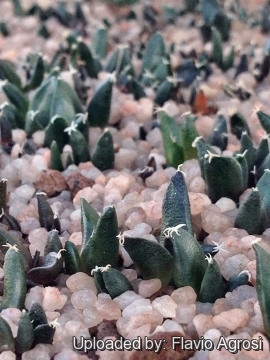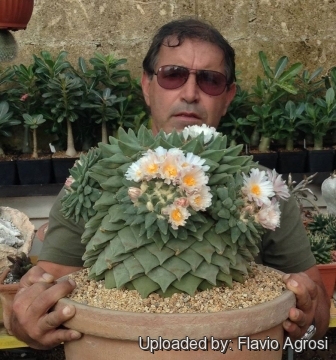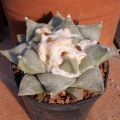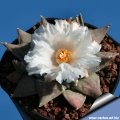Accepted Scientific Name: Ariocarpus retusus Scheidw.
Bull. Acad. Roy. Sci. Bruxelles 5: 492 (t. 1). 1838

Cactus prismaticus (Ariocarpus retusus) Photo by: Valentino Vallicelli
( Living Rock or Seven Stars ) Only the leaf-like rosette of tubercles is visible on this plant. This is the largest species of the genus. It is also one of the easiest and fastest to grow. It might still take 6-10 years, to go from seeds to flowering size.
Origin and Habitat: Ariocarpus retususSN|2079]]SN|2079]] is widely distributed from north of Saltillo, Coahuila southwards to San Luis Potosi. Also found occur in Tamaulipas and Zacatecas.
Altitude range: High Chihuahuan desert at altitudes of between 1300 and 2000 metres above sea level. This species grows at lower altitudes (around 200 - 800 metres) of the Sierra Madre Oriental it is replaced by Ariocarpus retususSN|2079]]SN|2079]] ssp. trigonus.
Habitat: The species tends to favour limestone and rocky slopes in semi-desert vegetation. The original range of this species extended from Coahuila and Nuevo León in the north to San Luis Potosí in the south. However, much of this range has been modified by agricultural development. A. retusus is a perennial and obligate gypsophile, occurring regularly in Muhlenbergia grassland and Bouteloua grassland in Central Mexico. Ariocarpus species are the only succulents present in the Muhlenbergia grassland. Although A. retusus has a relatively extensive area of distribution and a large population, it has a very low density. It is a slow growing species. This species is threatened by illegal collecting and agricultural development, however, they do not represent major threats. It is found in commercial cultivation.
Synonyms:
See all synonyms of Ariocarpus retusus
back
Accepted name in llifle Database:Ariocarpus retusus Scheidw.Bull. Acad. Roy. Sci. Bruxelles 5: 492 (t. 1). 1838Synonymy: 31
Accepted name in llifle Database:Ariocarpus retusus subs. trigonus (F.A.C.Weber) E.F.Anderson & W.A.Fitz Maur.Haseltonia 5: 18. 1998 [1997 publ. 1998]Synonymy: 7
Cultivars
(11):
back
Common Names include:
ENGLISH: Star Rock, Living Rock, False Peyote
HUICHOL: Tsuwíri
LITHUANIAN (Lietuvių): Dubusis ariokarpas
RUSSIAN (Русский): Ариокарпус притуплённый
SPANISH (Español): Peyote, Falso Peyote, Cimarrón, Biznaga-Maguey, Peyote Cimarrón, Chaute, Chautle
SWEDISH (Svenska): Myrkottskaktus
UKRAINIAN (Українська): Аріокарпус притуплений
Description: Ariocarpus retususSN|2079]]SN|2079]]us commonly known as the "Star Rock" is one of the largest species that distinguishes for the fat triangular tubercles forming a starry rosette. It is a widespread and extremely variable plant. Tubercle size and shape vary widely, a terminal areole is sometimes present at the tip. The vast amount of phenotypic variation in the species has led to the erection of several variants and has received numerous unnecessary names of no botanical value.
Habit: Solitary, slow growing geophyte cactus with tubercles slightly projecting above ground level. The flat tuberous body is below the soil.
Stem: Grey, or blue-green, flattened, globose, rounded on top, 3-12 cm high, 10-25 cm in diameter.
Tubercles: Leaf-like, divergent, erect, basally compressed, usually becoming attenuate at the apices, convex or nearly flattened adaxially and often with shallow adaxial undulations or wrinkling, not fissured, 1,5-4 cm long, 1-3,5 cm wide, nearly as wide as long.
Areoles: At the tips of the tubercles, rounded, 1-5 mm in diameter often only on younger specimens.
Flowers: Diurnal 4-5cm in diameter, 2-4,2 cm long, white to pink (or magenta), occasionally with reddish midribs.
Roots: Tap root.
Flowering time: Autumn.
Fruits: White, green, or rarely pinkish, 10-25 mm long, 3-10 mm in diameter.
Remarks: All of the Ariocarpus seedlings are spiny and quite different from adult specimens, though the spines are feather-like.
Subspecies, varieties, forms and cultivars of plants belonging to the Ariocarpus retusus group
 Ariocarpus confusus Halda & Horáček: intermediates between Ariocarpus retusus and Ariocarpus trigonus flower color, white through to magenta, a color not found in any other populations. Distribution: Aramberri region.
Ariocarpus confusus Halda & Horáček: intermediates between Ariocarpus retusus and Ariocarpus trigonus flower color, white through to magenta, a color not found in any other populations. Distribution: Aramberri region. Ariocarpus elongatus (Salm-Dyck) Wettst.: has longer an narrower tubercles than Ariocarpus retusus. Distribution: Huizache, San Luis Potosí.
Ariocarpus elongatus (Salm-Dyck) Wettst.: has longer an narrower tubercles than Ariocarpus retusus. Distribution: Huizache, San Luis Potosí. Ariocarpus furfuraceus C.H.Thomps.: has equilaterally triangular shaped tubercles.
Ariocarpus furfuraceus C.H.Thomps.: has equilaterally triangular shaped tubercles. Ariocarpus furfuraceus f. cristata Frič: crested form.
Ariocarpus furfuraceus f. cristata Frič: crested form. Ariocarpus furfuraceus f. monstruosus hort.: Free branching plants with thinner elongated stems and copious production of wool. There are several different clones.
Ariocarpus furfuraceus f. monstruosus hort.: Free branching plants with thinner elongated stems and copious production of wool. There are several different clones.- Ariocarpus furfuraceus var. rostratus A.Berger: (Ariocarpus retusus var. furfuraceus ''rostratus'') Refers to plants with a more tapered apex to the tubercle.
 Ariocarpus retusus Scheidw.: (ssp. retusus) Widespread, flowers are cream or white, occasionally with reddish midveins.
Ariocarpus retusus Scheidw.: (ssp. retusus) Widespread, flowers are cream or white, occasionally with reddish midveins. Ariocarpus retusus f. cristata hort.: is a slow-growing crested cactus forming with fan shaped stems that will slowly forms brain-shaped cushion up to 3-12 cm high and 70 cm in diameter, or more.
Ariocarpus retusus f. cristata hort.: is a slow-growing crested cactus forming with fan shaped stems that will slowly forms brain-shaped cushion up to 3-12 cm high and 70 cm in diameter, or more. Ariocarpus retusus subs. horacekii Halda & Panar.: like Ariocarpus trigonus but smaller. Distribution: South of Matehuala, San Luis Potosí.
Ariocarpus retusus subs. horacekii Halda & Panar.: like Ariocarpus trigonus but smaller. Distribution: South of Matehuala, San Luis Potosí.- Ariocarpus retusus subs. jarmilae Halda, Horáček & Panar.: nomina nuda
- Ariocarpus retusus subs. panarottoi Halda & Horáček: Nomina nuda.
 Ariocarpus retusus subs. pectinatus Weisbarth: It has, dull pectinated spines already present in young specimens up to 1,2 to 2,0 mm long. The spines persist with the age. Areoles at the tips and extending on the upper side of the tubercles, elongated 2 to 20 mm long, wooly.
Ariocarpus retusus subs. pectinatus Weisbarth: It has, dull pectinated spines already present in young specimens up to 1,2 to 2,0 mm long. The spines persist with the age. Areoles at the tips and extending on the upper side of the tubercles, elongated 2 to 20 mm long, wooly.- Ariocarpus retusus subs. scapharostroides Halda & Horáček: Plants from the Villa Juarez region of SLP, it is characterized by erect angular tubercles, superficially reminiscent of Ariocarpus scapharostrus.
- Ariocarpus retusus var. sladkovskyi Halda & Kupčák
 Ariocarpus retusus subs. trigonus (F.A.C.Weber) E.F.Anderson & W.A.Fitz Maur.: (Ariocarpus retusus ssp. trigonus) Somewhat less widespread with long sharp tubercles twice as long as wide. The flowers are yellow (usually), white to pinkish white.
Ariocarpus retusus subs. trigonus (F.A.C.Weber) E.F.Anderson & W.A.Fitz Maur.: (Ariocarpus retusus ssp. trigonus) Somewhat less widespread with long sharp tubercles twice as long as wide. The flowers are yellow (usually), white to pinkish white. Ariocarpus retusus cv. Cauliflower: has a completely or partially warty skin that gives it an aspect of cauliflower.
Ariocarpus retusus cv. Cauliflower: has a completely or partially warty skin that gives it an aspect of cauliflower.- Ariocarpus retusus cv. Cauliflower King: This is a variant of cv. cauliflower with bigger, if not huge, tubercles giving an overall appearance rather globular.
 Ariocarpus retusus cv. Frumdosus: Unlike the type species, this cultivar has not convex, bulging tubers, but flat and smooth giving them an aspect of tetrahedron.
Ariocarpus retusus cv. Frumdosus: Unlike the type species, this cultivar has not convex, bulging tubers, but flat and smooth giving them an aspect of tetrahedron.  Ariocarpus retusus cv. Frumdosus brevituberosus
Ariocarpus retusus cv. Frumdosus brevituberosus Ariocarpus retusus cv. Frumdosus f. variegata
Ariocarpus retusus cv. Frumdosus f. variegata Ariocarpus retusus cv. Maruibo: Unlike the type species that has more or less triangular tubers, here they take a round shape and looks like small spheres ending with a large woolly areolae.
Ariocarpus retusus cv. Maruibo: Unlike the type species that has more or less triangular tubers, here they take a round shape and looks like small spheres ending with a large woolly areolae. Ariocarpus retusus cv. Maruibo Cauliflower: A pretty good combination of "Maruibo" and "Cauliflower" character.
Ariocarpus retusus cv. Maruibo Cauliflower: A pretty good combination of "Maruibo" and "Cauliflower" character. Ariocarpus retusus cv. Maruibo Pectinatus: is characterized by the swollen tubercles of "Maruibo" together with the very woolly and sometimes prickly central groove of "Pectinatus".
Ariocarpus retusus cv. Maruibo Pectinatus: is characterized by the swollen tubercles of "Maruibo" together with the very woolly and sometimes prickly central groove of "Pectinatus". Ariocarpus retusus cv. Mituibo: (a.k.a. cv. Three Finger or Tresfinger)The tip of each tubercles is split into three points as three fingers, a bit like a trident with a large central section and two smaller ones on each side.
Ariocarpus retusus cv. Mituibo: (a.k.a. cv. Three Finger or Tresfinger)The tip of each tubercles is split into three points as three fingers, a bit like a trident with a large central section and two smaller ones on each side. Ariocarpus retusus cv. Tama Botan: (a.k.a. Ariocarpus retusus var. major) It is a cultivated selection with very wide leaflike, divergent tubercles. The tubercles are 3,5 to 5 cm wide, and are as wide as long or wider in adult specimens.
Ariocarpus retusus cv. Tama Botan: (a.k.a. Ariocarpus retusus var. major) It is a cultivated selection with very wide leaflike, divergent tubercles. The tubercles are 3,5 to 5 cm wide, and are as wide as long or wider in adult specimens.
Bibliography: Major references and further lectures
1) Edward F. Anderson “The Cactus Family” Timber Press, 2001
2) Curt Backeberg “Cactus Lexicon” Sterling Publishing Company, Incorporated, 1978
3) Hiroshi Hirao “Colour encyclopaedia of cacti” Japan 1979 (Japanese language and script)
4) Willy Cullmann, Erich Götz (Dozent Dr.), Gerhard Gröner “The encyclopedia of cacti” Portland, OR: Timber Press, 1986
5) David Hunt, Nigel Taylor “The New Cactus Lexicon” DH Books, 2006
6) James Cullen, Sabina G. Knees, H. Suzanne Cubey “The European Garden Flora Flowering Plants: A Manual for the Identification of Plants Cultivated in Europe, Both Out-of-Doors and Under Glass” Cambridge University Press, 11/Aug./2011
7) Fitz Maurice, B & Fitz Maurice, W.A. 2013. "Ariocarpus retusus." The IUCN Red List of Threatened Species. Version 2014.3. <www.iucnredlist.org>. Downloaded on 12 December 2014.
 - ( Living Rock or Seven Stars ) Only the leaf-like rosette of tubercles is visible on this plant. This is the largest species of the genus. It is also one of the easiest and fastest to grow. It might still take 6-10 years, to go from seeds to flowering size. (Ariocarpus retusus) Photo by: Andrea B.
- ( Living Rock or Seven Stars ) Only the leaf-like rosette of tubercles is visible on this plant. This is the largest species of the genus. It is also one of the easiest and fastest to grow. It might still take 6-10 years, to go from seeds to flowering size. (Ariocarpus retusus) Photo by: Andrea B. In habitat Mexico. (Ariocarpus retusus) Photo by: Agócs György
In habitat Mexico. (Ariocarpus retusus) Photo by: Agócs György Ariocarpus retusus LH453 Las Tablas (Ariocarpus retusus) Photo by: Cactus Art
Ariocarpus retusus LH453 Las Tablas (Ariocarpus retusus) Photo by: Cactus Art Cactus prismaticus (Ariocarpus retusus) Photo by: Valentino Vallicelli
Cactus prismaticus (Ariocarpus retusus) Photo by: Valentino Vallicelli Seedlings (Ariocarpus retusus) Photo by: Flavio Agrosi
Seedlings (Ariocarpus retusus) Photo by: Flavio Agrosi Cactus prismaticus (Ariocarpus retusus) Photo by: Flavio Agrosi
Cactus prismaticus (Ariocarpus retusus) Photo by: Flavio Agrosi Cactus prismaticus (Ariocarpus retusus) Photo by: Cactus Art
Cactus prismaticus (Ariocarpus retusus) Photo by: Cactus Art Cactus prismaticus (Ariocarpus retusus) Photo by: Valentino Vallicelli
Cactus prismaticus (Ariocarpus retusus) Photo by: Valentino VallicelliCultivation and Propagation: This species is slow growing but certainly not as slow as some other types of cacti, it is of easy culture in a well drained, non-organic, free-draining soil compost, with ample water during the growing season. Use of a weak low-nitrogen fertilizer during the growing season can encourage growth. The main threat to their development is root rot. Ariocarpus should be kept dry whenever there is a threat of cold. The appearance of Ariocarpus can benefit greatly by watering the plants from the bottom. This practice will help to keep the “wool” on the top of the plant from becoming matted or discoloured. Need light shade to full sun. Frost Tolerance: Hardy to -10° C.
Propagation: It is probably the easiest species of the genus to raise from seed, but will generally take about 6-10 years to reach flowering size, occasionally grafted.
Your Photos

by Valentino Vallicelli

by Valentino Vallicelli

by Valentino Vallicelli

by Cactus Art

by Valentino Vallicelli























